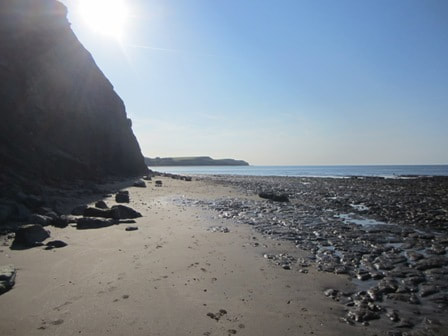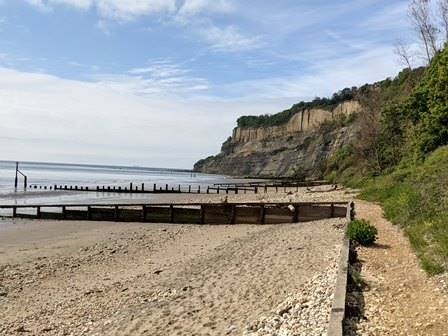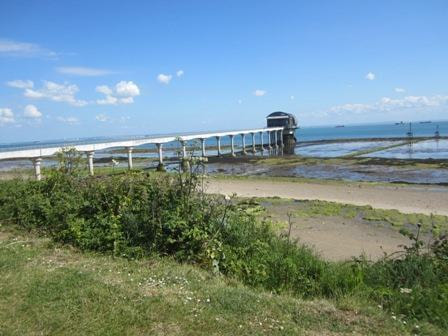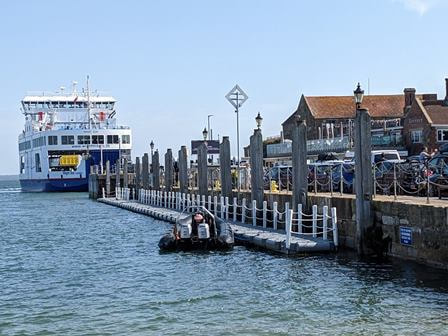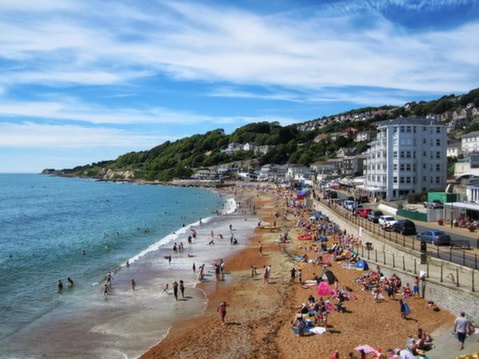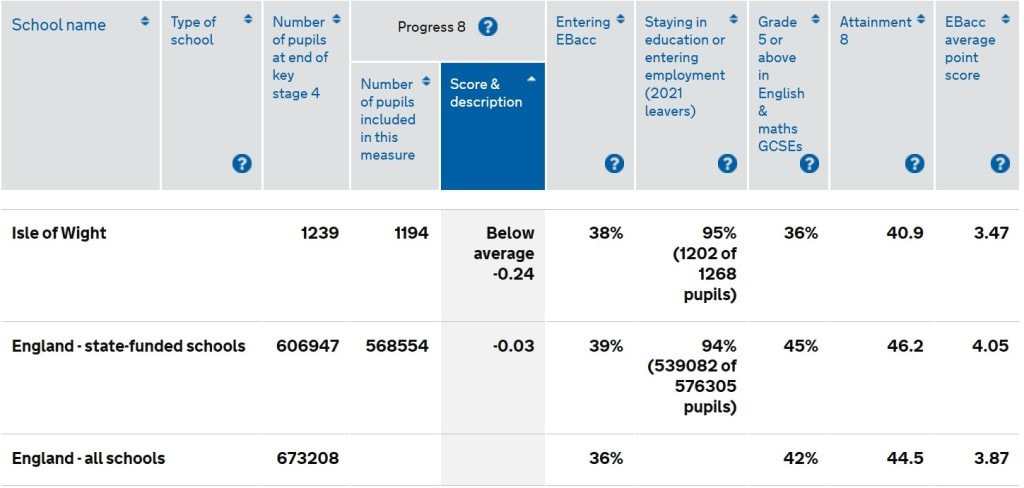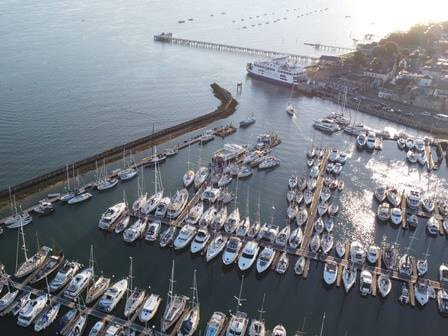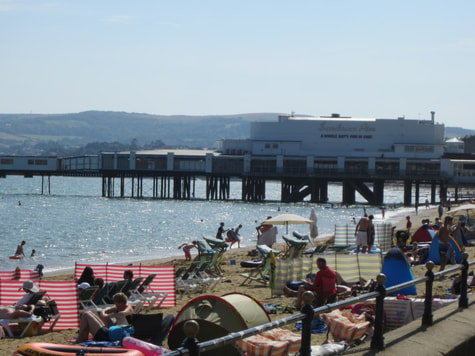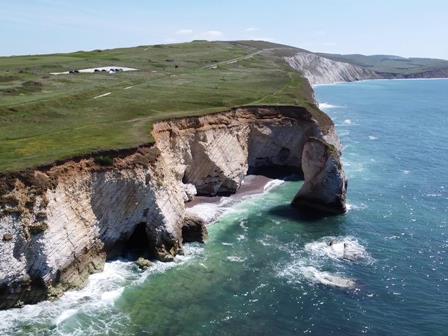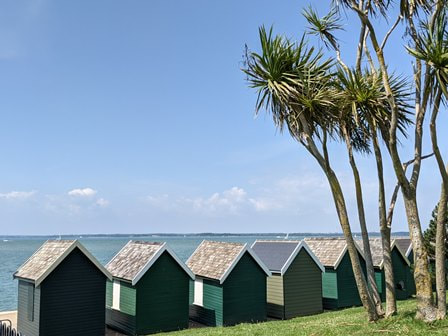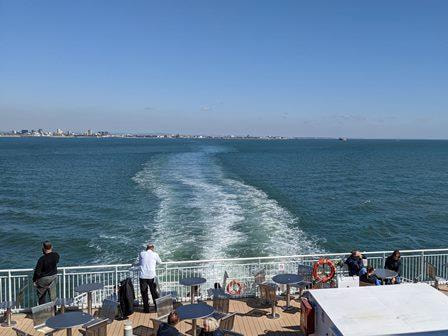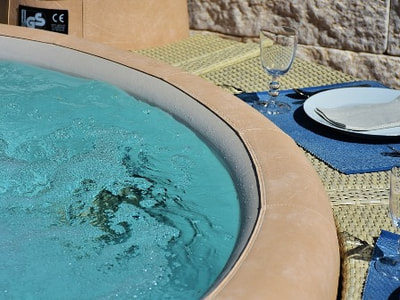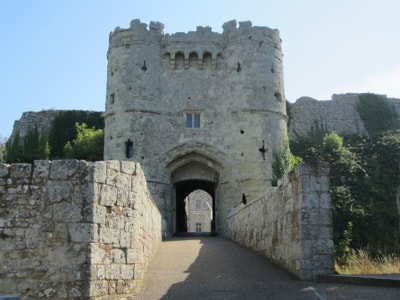This site uses cookies - see our privacy policy. Ads & links in bold may give us a small payment from the seller, at no cost to the buyer. However, this never affects our views - if we like it, we recommend it.
Should I move to the Isle of Wight? 2024 Guide
Thinking of extending your holiday by moving to the Isle of Wight? Here's our guide to house prices, schools, job opportunities and quality of life.
Q. Is there much to do on the Isle of Wight?
Yes! Whilst most people move to the Isle of Wight for a slower pace of life, the Island is (in my view) actually a really interesting place to live. There are numerous summer festivals, carnivals and events as well as miles of beautiful beaches, 500 miles of public footpath, interesting wildlife and more sunshine than most of the UK (500 hours a year more than London). There are dozens of decent attractions for children and adults as well as plenty of free things to do and loads of places to eat out whilst admiring the view.
It's also small enough that you can get anywhere within 25 minutes from the centre but not so small that you need to be constantly hopping to the mainland. You rarely 'need' to go to the mainland as the Isle of Wight has all the usual facilities such as large supermarkets, schools, cinemas, a bowling alley etc.
It's also small enough that you can get anywhere within 25 minutes from the centre but not so small that you need to be constantly hopping to the mainland. You rarely 'need' to go to the mainland as the Isle of Wight has all the usual facilities such as large supermarkets, schools, cinemas, a bowling alley etc.
I will admit that things do slow down significantly during the winter and that nightlife is very limited compared to a city - which may be frustrating for older teenagers and 20 somethings. However, many islanders enjoy winter seaside walks when car parking is easier, and the roads are quieter.
Read our blog post called: 'An Isle of Wight myth: there's nothing for teenagers'
Read our blog post called: 'An Isle of Wight myth: there's nothing for teenagers'
Q. What are the downsides of living on the Isle of Wight
I'm afraid it's not all glorious walks on sunlit beaches and dinners in seaside restaurants.
Some public services on the Isle of Wight score below average in league tables, average salaries are lower than the south-east and you will have to deal with the cost and inconvenience of catching a ferry to visit the mainland. There are other issues too, such as a shortage of residential rental properties, limited year-round employment prospects in some sectors, a shortage of NHS dentists, extra charges for deliveries from some couriers, below average school exam results and an uneven demography compared to other counties. Some hospital outpatient appointments also require a trip to the mainland.
I will cover some of these in much wafflier detail.
Some public services on the Isle of Wight score below average in league tables, average salaries are lower than the south-east and you will have to deal with the cost and inconvenience of catching a ferry to visit the mainland. There are other issues too, such as a shortage of residential rental properties, limited year-round employment prospects in some sectors, a shortage of NHS dentists, extra charges for deliveries from some couriers, below average school exam results and an uneven demography compared to other counties. Some hospital outpatient appointments also require a trip to the mainland.
I will cover some of these in much wafflier detail.
Q. Are house prices high on the Isle of Wight?
As a rule of thumb, house and other property prices on the Isle of Wight are lower than most of the South but more than most of the Midlands and North of England.
As of December 2023, the average selling price of houses on the Isle of Wight is £306,000, compared to £389,000 for Hampshire, £243,000 for Nottinghamshire and £201,000 for Lancashire (source: Zoopla, 2023, average price paid over the last 12 months).
Of course, the Isle of Wight has cheaper and more expensive parts. In order of average value:
As of December 2023, the average selling price of houses on the Isle of Wight is £306,000, compared to £389,000 for Hampshire, £243,000 for Nottinghamshire and £201,000 for Lancashire (source: Zoopla, 2023, average price paid over the last 12 months).
Of course, the Isle of Wight has cheaper and more expensive parts. In order of average value:
- Yarmouth (£557,000 average property value based on sales in previous 12 months)
- Bembridge (£489,000)
- Seaview (£438,000)
- Totland Bay (£380,000)
- Freshwater (£353,000)
- Cowes (£316,000)
- Ventnor (£313,000)
- Shanklin (£272,000)
- Ryde (£272,000)
- Sandown (£264,000)
- East Cowes (£243,000)
- Newport (£228,000)
(Source: Zoopla, December 2023, average price paid in the last 12 months).
It's worth saying that prices in Yarmouth and Bembridge have gone up a lot in the last couple of years compared to other parts of the Isle of Wight.
Back in October 2021, Zoopla's average price for the previous 12 months was £459,000 in Yarmouth and £429,000 Bembridge. That means Yarmouth's average price shot up by about £100,000 in two years. It's only a small town, so there may not be much data to go on.
The Isle of Wight average price actually hasn't changed much in the last couple of years. It was £305,000 in 2021 and £306,000 in 2023. Newport's average price has dropped from £256,000 in 2021 to £228,000 in 2023. Of course, when you get down to a more local level the numbers are based on a small number of properties.
You can certainly pick up a 3-bed terraced house in a seaside town such as Sandown for around £225,000 - £250,000.
You may want to check out our guide to which Isle of Wight town should I stay in? That will give you an idea of what the different towns are like.
Q. Are there any unusual restrictions around house buying on the Isle of Wight?
No, not that I know of. The Isle of Wight is treated in the same way as any other English county, with the same banks offering the same mortgages. You don't have to pay more for some properties or anything like that if you weren't born on the Isle of Wight (unlike Guernsey, which has some different rules). If you can legally buy a house in Hampshire, you can buy a house on the Isle of Wight.
You also don't have to undergo any rituals or initiation ceremonies like running over hot coals when you arrive.
You also don't have to undergo any rituals or initiation ceremonies like running over hot coals when you arrive.
Q. What are house rental prices like on the Isle of Wight?
If you’re looking for long term rental properties (as opposed to short term holiday rentals), then prices seem to follow a similar pattern to the house buying market.
However, it's important to say that 'the Isle of Wight's rental market has shrunk by 83 per cent since the start of the Covid pandemic' and that 'rental property availability has dropped from an average of 350 homes a month in December 2019 to around 60 in October 2021'.
As of December 2023, the overall average monthly rental price (according to Home.co.uk) is £1093 on the Isle of Wight compared to £1596 in Hampshire and £929 in Lancashire. So, it's similar to the house buying market where the Isle of Wight is cheaper than most of the South, but similar in price or more expensive than the Midlands and North.
Using the same source (Home.co.uk, December 2023), the average price for a two-bedroom property is £895 per month. Three bedrooms will cost you around £1216 and then there’s a jump up to £1753 for four bedrooms. However, the data sets are pretty small (there are only 13 different four-bedroom properties listed according to Home.co.uk). A quick search on Rightmove shows that there are a couple around £1400 per month. Obviously, this is only correct at the time of searching, as properties come and go.
Generally speaking, Isle of Wight towns with cheaper houses to buy are also cheaper to rent - which isn't a great surprise. However, the difference isn't as significant as the difference in house prices. Buying a property in Bembridge might cost you almost twice as much as one in Sandown, but renting one isn't twice the price.
However, it's important to say that 'the Isle of Wight's rental market has shrunk by 83 per cent since the start of the Covid pandemic' and that 'rental property availability has dropped from an average of 350 homes a month in December 2019 to around 60 in October 2021'.
As of December 2023, the overall average monthly rental price (according to Home.co.uk) is £1093 on the Isle of Wight compared to £1596 in Hampshire and £929 in Lancashire. So, it's similar to the house buying market where the Isle of Wight is cheaper than most of the South, but similar in price or more expensive than the Midlands and North.
Using the same source (Home.co.uk, December 2023), the average price for a two-bedroom property is £895 per month. Three bedrooms will cost you around £1216 and then there’s a jump up to £1753 for four bedrooms. However, the data sets are pretty small (there are only 13 different four-bedroom properties listed according to Home.co.uk). A quick search on Rightmove shows that there are a couple around £1400 per month. Obviously, this is only correct at the time of searching, as properties come and go.
Generally speaking, Isle of Wight towns with cheaper houses to buy are also cheaper to rent - which isn't a great surprise. However, the difference isn't as significant as the difference in house prices. Buying a property in Bembridge might cost you almost twice as much as one in Sandown, but renting one isn't twice the price.
Looking for discount Isle of Wight ferry travel?
Q. Are there many jobs on the Isle of Wight?
Unfortunately, the Isle of Wight does have higher unemployment levels than other parts of the South East region. However, current data suggests it's not all that different to the rest of Great Britain.
According to Nomis (using Office of National Statistics data), the Isle of Wight had a 5% unemployment rate in 2022-2023, compared to 3.4% in the South East or 3.8% across Great Britain (this is 'economically active' people and excludes retired people, children etc).
A more negative figure from Nomis (using ONS data from 2022) concluded that 24.8% of Isle of Wight households are 'workless' compared to 11.1% in the South East or 13.9% across Great Britain. That includes any household with at least one person aged 16-64. Perhaps I am way off, but my hunch is that this is skewed by people who take early retirement and move to the Isle of Wight.
According to Nomis (using Office of National Statistics data), the Isle of Wight had a 5% unemployment rate in 2022-2023, compared to 3.4% in the South East or 3.8% across Great Britain (this is 'economically active' people and excludes retired people, children etc).
A more negative figure from Nomis (using ONS data from 2022) concluded that 24.8% of Isle of Wight households are 'workless' compared to 11.1% in the South East or 13.9% across Great Britain. That includes any household with at least one person aged 16-64. Perhaps I am way off, but my hunch is that this is skewed by people who take early retirement and move to the Isle of Wight.
Further data from Nomis/ONS concludes that a higher proportion of people work part time on the Isle of Wight than the rest of Great Britain (38% compared to 31.2% in 2022).
Regarding employment sectors, Nomis/ONS say that as of 2022 people on the Isle of Wight work in:
The sectors where there don't seem to be many jobs, compared to the rest of Great Britain are 'Information And Communication', 'Financial And Insurance Activities' and 'Professional, Scientific And Technical Activities'.
If you are currently house hunting, you may be interested to know that the Isle of Wight has an average number of Estate Agents according to official data...
Regarding employment sectors, Nomis/ONS say that as of 2022 people on the Isle of Wight work in:
- 'Human Health And Social Work Activities' (16% - higher than the Great Britain average)
- 'Wholesale And Retail Trade; Repair Of Motor Vehicles And Motorcycles' (16% - higher than the Great Britain average)
- 'Accommodation And Food Service Activities' (14% - almost double the Great Britain average)
- Manufacturing (8% - about average for Great Britain)
- Education (9% - average for Great Britain)
The sectors where there don't seem to be many jobs, compared to the rest of Great Britain are 'Information And Communication', 'Financial And Insurance Activities' and 'Professional, Scientific And Technical Activities'.
If you are currently house hunting, you may be interested to know that the Isle of Wight has an average number of Estate Agents according to official data...
Q. What is the average salary on the Isle of Wight?
Most of the indicators and studies I’ve found suggest that the Isle of Wight’s average salary is below the UK average.
ONS data from 2022 says that the average hourly wage on the Isle of Wight for full time workers is £16.50 compared to £18.70 in the South East or £17.49 across Great Britain.
An article about 2015-16 tax returns from OnTheWight claims that 'the average total income for taxpayers in the area was 22% lower than the UK average of £33,400' which is roughly similar to the data from 2022 mentioned above.
Meanwhile, a website called Plumpot reckons that the Isle of Wight's average salary for full time employees is £32,300 compared to a UK average of £40,000.
ONS data from 2022 says that the average hourly wage on the Isle of Wight for full time workers is £16.50 compared to £18.70 in the South East or £17.49 across Great Britain.
An article about 2015-16 tax returns from OnTheWight claims that 'the average total income for taxpayers in the area was 22% lower than the UK average of £33,400' which is roughly similar to the data from 2022 mentioned above.
Meanwhile, a website called Plumpot reckons that the Isle of Wight's average salary for full time employees is £32,300 compared to a UK average of £40,000.
Q. Where can I find jobs on the Isle of Wight?
Some of the big national job websites don't work very well for Isle of Wight jobs, because they ask for a radius. If you search for jobs within 10 miles of an Isle of Wight postcode you'll end up with loads of positions in Southampton and Portsmouth.
Job websites worth looking at include:
Job websites worth looking at include:
- Isle of Wight Jobs
- Wightbay Jobs
- Jobs On The Wight
- Indeed
- Isle of Wight Council Jobs
- Isle of Wight County Press Jobs
- WP Recruitment
- NHS Jobs (Search for Isle of Wight rather than a postcode)
- Guardian Jobs
Q. So, is it practical to commute to the mainland?
It depends where you live.
Towns like Sandown, Shanklin and Ryde are on a train line that links up with a 22-minute Wightlink passenger ferry to Portsmouth meaning that you could get from home to Portsmouth Harbour in around 40-60 minutes. The Hovercraft only takes 10 minutes, but it ends up in Southsea, rather than at Portsmouth Harbour rail station.
(West) Cowes has a 28-minute Red Funnel passenger ferry to Southampton - although it's another bus ride to get to Southampton Central train station. Assuming that your office is near to the ferry port then you could potentially get from home to work in as little as 45 minutes.
Yarmouth has a 40-minute car and passenger ferry which goes to Lymington Pier. Getting to Lymington itself could be achieved in about 60 minutes potentially.
In 2023 you will pay £2954 a year for a Red Funnel foot passenger season ticket (about £12 a day, based on a 5-day week with holidays) or £1900 for a Wightlink one (about £8 a day).
Commuting from other towns and villages in the South Wight, such as Ventnor will take much longer (at least 90 minutes).
Getting to London each day from anywhere on the Isle of Wight is probably a bit ambitious - the best you are likely to manage is about 2 1/2 hours door to door.
Towns like Sandown, Shanklin and Ryde are on a train line that links up with a 22-minute Wightlink passenger ferry to Portsmouth meaning that you could get from home to Portsmouth Harbour in around 40-60 minutes. The Hovercraft only takes 10 minutes, but it ends up in Southsea, rather than at Portsmouth Harbour rail station.
(West) Cowes has a 28-minute Red Funnel passenger ferry to Southampton - although it's another bus ride to get to Southampton Central train station. Assuming that your office is near to the ferry port then you could potentially get from home to work in as little as 45 minutes.
Yarmouth has a 40-minute car and passenger ferry which goes to Lymington Pier. Getting to Lymington itself could be achieved in about 60 minutes potentially.
In 2023 you will pay £2954 a year for a Red Funnel foot passenger season ticket (about £12 a day, based on a 5-day week with holidays) or £1900 for a Wightlink one (about £8 a day).
Commuting from other towns and villages in the South Wight, such as Ventnor will take much longer (at least 90 minutes).
Getting to London each day from anywhere on the Isle of Wight is probably a bit ambitious - the best you are likely to manage is about 2 1/2 hours door to door.
Q. How expensive is it to get to the mainland?
There's no getting away from the fact that the Isle of Wight ferry can be very expensive, particularly if you travel at peak times with a car. However, there are deals to be had and the obstacle of the ferry does help to keep the Isle of Wight's slower pace of life. As a very broad guide, you can expect to pay about £50 to £300 for a car with passengers or about £15 to £40 for a day return as a passenger.
Q. do Isle of Wight residents get a ferry discount?
Well, sort of.
If you just visit the Red Funnel or Wightlink website and attempt to book a standard ferry fare, then Isle of Wight residents pay pretty much identical prices to visitors. In fact, Red Funnel and Wightlink sometimes run special offers that are only valid for travel to the Isle of Wight (to encourage holidaymakers to visit) meaning that residents actually end up missing out and paying a bit more.
However, it isn't all bad news.
Wightlink run a 'Multilink' discount scheme for those with an Isle of Wight residence, which works out at about £65 for a car return journey. You buy a book of five returns which are valid for 12 months, but it's still good value if you don't use the ferry as often as that (see our Multilink guide or our blog called 'How Isle of Wight residents can get the car ferry for £53').
Meanwhile, Red Funnel run a discount scheme for regular travellers wherever they live, with a reduction of up to 20%. If you combine it with their loyalty card, you are effectively getting almost 24% off.
There are several other things you can do to make the ferry cheaper for family who might want to visit you now that you're living by the seaside - such as collecting Tesco Clubcard points, using a discount code or using a Blue Badge. It is also worth signing up for Red Funnel's marketing mailing list or Wightlink's mailing list, as they sometimes send out special offers just for Isle of Wight residents and their friends and family.
If you just visit the Red Funnel or Wightlink website and attempt to book a standard ferry fare, then Isle of Wight residents pay pretty much identical prices to visitors. In fact, Red Funnel and Wightlink sometimes run special offers that are only valid for travel to the Isle of Wight (to encourage holidaymakers to visit) meaning that residents actually end up missing out and paying a bit more.
However, it isn't all bad news.
Wightlink run a 'Multilink' discount scheme for those with an Isle of Wight residence, which works out at about £65 for a car return journey. You buy a book of five returns which are valid for 12 months, but it's still good value if you don't use the ferry as often as that (see our Multilink guide or our blog called 'How Isle of Wight residents can get the car ferry for £53').
Meanwhile, Red Funnel run a discount scheme for regular travellers wherever they live, with a reduction of up to 20%. If you combine it with their loyalty card, you are effectively getting almost 24% off.
There are several other things you can do to make the ferry cheaper for family who might want to visit you now that you're living by the seaside - such as collecting Tesco Clubcard points, using a discount code or using a Blue Badge. It is also worth signing up for Red Funnel's marketing mailing list or Wightlink's mailing list, as they sometimes send out special offers just for Isle of Wight residents and their friends and family.
Q. Are the schools any good on the Isle of Wight?
A few years ago, the Isle of Wight's schools went through a major restructuring. They moved from a three-tier system (Primary, Middle, High) to a two-tier system (Junior, Secondary). Some schools have closed or merged because the number of buildings didn't suit the number of pupils. Once you combine that with changes to schools at a national level you end up with a school system that has seen a huge amount of change.
It's an emotive topic so I will avoid giving any personal opinions, apart from pointing out the obvious.
Regarding secondary schools, according to a 2022 article from the Isle of Wight Observer, "the Island’s GCSE and A-level results are lower than any other county". The article is titled 'Education officers dismiss official exam result figures'.
However, an article from On The Wight in 2022 tells a slightly different story about provisional GCSE data:
"The Island has out-performed authorities such as Middlesborough in the North-East, Blackpool in the North-West, Stoke-on-Trent in the Midlands, North-East Lincolnshire in the Yorkshire and the Humber region and neighbouring Portsmouth in the South-East."
For those who prefer to trawl through numbers, there is some useful data on the government's school performance website about individual schools. We've stuck in a screenshot of the summary for the whole Isle of Wight, as of December 2023.
It's an emotive topic so I will avoid giving any personal opinions, apart from pointing out the obvious.
Regarding secondary schools, according to a 2022 article from the Isle of Wight Observer, "the Island’s GCSE and A-level results are lower than any other county". The article is titled 'Education officers dismiss official exam result figures'.
However, an article from On The Wight in 2022 tells a slightly different story about provisional GCSE data:
"The Island has out-performed authorities such as Middlesborough in the North-East, Blackpool in the North-West, Stoke-on-Trent in the Midlands, North-East Lincolnshire in the Yorkshire and the Humber region and neighbouring Portsmouth in the South-East."
For those who prefer to trawl through numbers, there is some useful data on the government's school performance website about individual schools. We've stuck in a screenshot of the summary for the whole Isle of Wight, as of December 2023.
Secondary school Ofsted results as of December 2023 look like this:
For Primary Schools, I would suggest starting with the performance data from the government's website and Ofsted once you have decided which part of the Island you want to live in.
Overall at primary level in October 2021, the '% of pupils meeting the expected standard' was 59% compared to a national average of 65%. Reading, writing and maths progress was below average compared to the national figure, though not by much.
Of course, bear in mind that there are schools performing above the national average. This is just the picture for the whole Island.
- Zero 'outstanding' schools
- Seven 'good' schools
- Three schools 'require improvement'
- Zero 'inadequate' schools
For Primary Schools, I would suggest starting with the performance data from the government's website and Ofsted once you have decided which part of the Island you want to live in.
Overall at primary level in October 2021, the '% of pupils meeting the expected standard' was 59% compared to a national average of 65%. Reading, writing and maths progress was below average compared to the national figure, though not by much.
Of course, bear in mind that there are schools performing above the national average. This is just the picture for the whole Island.
Regarding Ofsted inspections, as of December 2023, 33 out of 43 eligible primary schools were rated at Good. None were outstanding, 10 required improvement, none were inadequate.
The primary school admissions policy on the Isle of Wight is currently that you get priority based on which is your nearest school. You can search for the nearest school to a particular address here.
The primary school admissions policy on the Isle of Wight is currently that you get priority based on which is your nearest school. You can search for the nearest school to a particular address here.
Q. Are there private schools/Independent schools on the Isle of Wight
Yes, there are two private/independent schools on the Isle of Wight.
Figures quoted above are correct at the time of writing (2023) and are only given as a rough guide. Both schools offer a sibling discount, but you may have to pay extra things like exam fees.
- Ryde School with Upper School is the larger of the two private/independent schools. It has about 800 pupils, ranging from ages 2-18. It is also the more expensive of the two schools, with day fees ranging from £9384 to £16,626 per year, or more if you go for one of the boarding options. About 15% of pupils are boarders.
The school is inspected by the Independent Schools Inspectorate, which has published a few documents on the school. The most useful document I found was a 2022 visit, where ISI inspectors rated Ryde School as 'excellent' (i.e. the top grade) for 'academic and other achievements' and 'good' (i.e. the second grade) for 'pupils' personal development'. For exam results, I looked at this government website. I found the data on Ryde School a little confusing, as it was showing zero for some categories (presumably because they take different exams to other schools rather than because everyone failed). You are probably better to look at the 'recent exam results' section on the school's own website.
- The Priory School of Our Lady of Walsingham is in Whippingham, near to East Cowes. It is a lot smaller than Ryde School and has about 175 pupils, aged 5-18. It doesn't offer boarding. Fees range from £6450 per year to £10,500 per year depending on how old you are.
It received a 'Good' rating by Ofsted in 2018 and was also inspected by the Independent Schools Inspectorate in 2023. As far as I can tell, the inspection was just a 'compliance' one rather than a more detailed assessment. It concluded that the school had met all the required standards, but doesn't give much qualitative information. You can rummage through exam data on this page. In the 'Attainment 8' category it scores 56.3 against the England average of 46.2.
Figures quoted above are correct at the time of writing (2023) and are only given as a rough guide. Both schools offer a sibling discount, but you may have to pay extra things like exam fees.
Q. Is the Isle of Wight a safe place to live?
The Isle of Wight certainly feels safe and news reports of serious violent crimes seem to (thankfully) be few and far between...but does it also have low crime levels as many people say, usually without any evidence to back it up? Is it the sort of place where people say "no-one-locks-their-door-round-here"?
As you might expect, the statistics are confusing.
For simplicity, let's just look at violent crime. According to Plumpot, there are 43 violent crimes per 1000 people on the Isle of Wight. That puts it 14th out of 52 with 1 being the county with the highest rate of crime per 1000 people (West Yorkshire was the highest). I checked the figures in 2023.
The same site also has a map showing Newport, Ryde and Sandown as the areas with above average levels of violent crime whilst most of the Island is well below average. The West Wight seems to deserve its sleepy reputation based on crime figures.
Let's look at some other data covering all crimes.
According to the excellent local news website, On The Wight, 'there was a rate of 74 crimes per 1,000 residents during 2017-18, below the England and Wales average of 84'. The same article reports that 'despite nationally rising, gun and knife possession offences on the Isle of Wight have dropped by two, to 97 incidents' and then adds that 'there has been one homicide, a murder or manslaughter'.
It's worth noting that the violent crime level is at its highest level in July and August, whilst it is at its lowest in January, February and March. Data on crimes per 1000 people seems to be calculated by dividing the population of 'workday people' by the number of crimes. The Isle of Wight's official 'population' is around 140,000 but it has around 2.5 million visitors each year, who presumably are not included in the population figure but would be included in the crime statistics if they had their handbag stolen whilst on holiday.
Perhaps your brain is hurting - the point is that the statistics may well imply that the Isle of Wight has a bigger crime problem than it actually does.
My conclusion? The Isle of Wight has always felt like a safe place to me, but it isn't notably different from most of England according to the stats.
As you might expect, the statistics are confusing.
For simplicity, let's just look at violent crime. According to Plumpot, there are 43 violent crimes per 1000 people on the Isle of Wight. That puts it 14th out of 52 with 1 being the county with the highest rate of crime per 1000 people (West Yorkshire was the highest). I checked the figures in 2023.
The same site also has a map showing Newport, Ryde and Sandown as the areas with above average levels of violent crime whilst most of the Island is well below average. The West Wight seems to deserve its sleepy reputation based on crime figures.
Let's look at some other data covering all crimes.
According to the excellent local news website, On The Wight, 'there was a rate of 74 crimes per 1,000 residents during 2017-18, below the England and Wales average of 84'. The same article reports that 'despite nationally rising, gun and knife possession offences on the Isle of Wight have dropped by two, to 97 incidents' and then adds that 'there has been one homicide, a murder or manslaughter'.
It's worth noting that the violent crime level is at its highest level in July and August, whilst it is at its lowest in January, February and March. Data on crimes per 1000 people seems to be calculated by dividing the population of 'workday people' by the number of crimes. The Isle of Wight's official 'population' is around 140,000 but it has around 2.5 million visitors each year, who presumably are not included in the population figure but would be included in the crime statistics if they had their handbag stolen whilst on holiday.
Perhaps your brain is hurting - the point is that the statistics may well imply that the Isle of Wight has a bigger crime problem than it actually does.
My conclusion? The Isle of Wight has always felt like a safe place to me, but it isn't notably different from most of England according to the stats.
Q. Is the Isle of Wight's hospital any good?
Reviewing a hospital isn’t easy. Inevitably a large organisation will have good bits and bad bits, and things change all the time. Statistics are often misleading and inspections only give a snapshot.
Like everyone else, I know many people who work in healthcare and it is easy to see any comparison as criticism of talented and dedicated professionals.
Equally, people want to have an idea of what the local hospital is like, beyond the odd anecdote. There’s also no point in spending taxpayers’ money on organisations like the Care Quality Commission (CQC) if we don’t pay attention to their findings.
Like everyone else, I know many people who work in healthcare and it is easy to see any comparison as criticism of talented and dedicated professionals.
Equally, people want to have an idea of what the local hospital is like, beyond the odd anecdote. There’s also no point in spending taxpayers’ money on organisations like the Care Quality Commission (CQC) if we don’t pay attention to their findings.
Where relevant, I compared St Mary’s Hospital (the Isle of Wight’s hospital) with the main hospitals in Southampton (Southampton General) and Portsmouth (Queen Alexandra) to give the numbers more context. They are very different in terms of size, but they are the next nearest option for Islanders and will also be hospitals a lot of people are familiar with.
I searched in December 2023.
Needless to say, there are many more stats to look through if you have the time, but those ones are a good start. This BBC tool is useful if you enjoy numbers as much as me.
My conclusions? Well, St Mary’s Hospitals is clearly a lot smaller than Southampton General and Queen Alexandra in terms of beds but does that affect quality of care and treatment?
According to the CQC, all three hospitals are good at some things and less good at others but St Mary's is 'good' overall.
Southampton General had a few more ‘outstandings’ than St Mary’s in the overall categories, but St Mary’s didn't have as many areas requiring improvement.
People considering moving to the Isle of Wight are also keen to understand if they would often need to travel to the mainland for medical appointments. I’m yet to find a list of services which aren’t available at St Mary’s (please contact me if you find one), but there is a list of available planned care services and acute care services.
If you're interested, have a read of this 2018 article, which reports that 'Seriously ill patients could be transferred from the Isle of Wight to the mainland under new proposal'. A more recent story from Isle of Wight Radio discusses the creation of a hub in Winchester for 'urology, orthopaedic and ear, nose and throat patients'.
Red Funnel, Wightlink and Hovertravel do special deals for hospital visits (see our guide to discount Isle of Wight ferry travel for more on those).
Stats are from NHS and CQC websites.
I searched in December 2023.
- St Mary’s hospital has 246 beds compared to 1300 beds at Southampton General and 1255 beds at Queen Alexandra (numbers vary a bit depending on what you include).
- The CQC say that St Mary’s Hospital is ‘Good’ in five out of five areas (safe, effective, responsive, caring and well-led). The scale goes: inadequate, requires improvement, good, outstanding. The CQC said that Queen Alexandra requires improvement in 1 of 5 areas. Southampton General 'requires improvement' overall but was outstanding in two areas, good in one area and required improvement in two areas. Both had a similar mix of 'good' and 'requires improvement' when you look at specific sections.
- Regarding A&E waiting times, St Mary's Hospital on the Isle of Wight was hitting the target time on about 76% of occasions compared to 85% across England. University Hospital Southampton NHS Trust was almost identical on 76% whilst Portsmouth Hospitals NHS Trust was 66% (this data is from 2019).
Needless to say, there are many more stats to look through if you have the time, but those ones are a good start. This BBC tool is useful if you enjoy numbers as much as me.
My conclusions? Well, St Mary’s Hospitals is clearly a lot smaller than Southampton General and Queen Alexandra in terms of beds but does that affect quality of care and treatment?
According to the CQC, all three hospitals are good at some things and less good at others but St Mary's is 'good' overall.
Southampton General had a few more ‘outstandings’ than St Mary’s in the overall categories, but St Mary’s didn't have as many areas requiring improvement.
People considering moving to the Isle of Wight are also keen to understand if they would often need to travel to the mainland for medical appointments. I’m yet to find a list of services which aren’t available at St Mary’s (please contact me if you find one), but there is a list of available planned care services and acute care services.
If you're interested, have a read of this 2018 article, which reports that 'Seriously ill patients could be transferred from the Isle of Wight to the mainland under new proposal'. A more recent story from Isle of Wight Radio discusses the creation of a hub in Winchester for 'urology, orthopaedic and ear, nose and throat patients'.
Red Funnel, Wightlink and Hovertravel do special deals for hospital visits (see our guide to discount Isle of Wight ferry travel for more on those).
Stats are from NHS and CQC websites.
Q. Will I be able to see a good GP on the Isle of Wight?
The most useful information I've found on GP practices on the Isle of Wight is the GP Patient Survey.
Each GP Practice is rated on whether patients 'find it easy to get through to this GP practice by phone', the 'overall experience' and so on. I believe this is based on the forms you see next to a tatty cardboard box in your GP waiting room.
There is loads of data to look through, but we've just picked out the 'overall experience' score, as of December 2023. We've also included the national average.
Keep in mind that each GP practice has a 'practice area' so you can't just sign up for the one with the highest rating. You may be limited to a choice of one or two depending on where you live.
You can find maps of the practice areas on most of the individual websites for the GP practices.
Each GP Practice is rated on whether patients 'find it easy to get through to this GP practice by phone', the 'overall experience' and so on. I believe this is based on the forms you see next to a tatty cardboard box in your GP waiting room.
There is loads of data to look through, but we've just picked out the 'overall experience' score, as of December 2023. We've also included the national average.
- Wight Primary Partnerships - Freshwater - 87% satisfied with overall experience
- Ventnor Medical Centre - Ventnor - 81%
- South Wight Medical Practice - Ventnor - 81%
- Argyll House - Ryde - 79%
- Medina Healthcare - Newport and Wootton - 79%
- St Helens Medical Centre - St Helens, East Wight - 79%
- Tower House Surgery - Ryde - 76%
- National average - 71%
- The Bay Medical Practice - Sandown - 69%
- East Cowes Medical Centre - East Cowes - 68%
- Esplanade Surgery - Ryde - 68%
- Cowes Medical Centre - Cowes - 66%
- Newport Health Centre - Carisbrooke - 61%
Keep in mind that each GP practice has a 'practice area' so you can't just sign up for the one with the highest rating. You may be limited to a choice of one or two depending on where you live.
You can find maps of the practice areas on most of the individual websites for the GP practices.
Q. Which Isle of Wight town should I live in?
Choosing which town to live in on the Isle of Wight really depends on what you are after, and inevitably what budget you are working to (see house prices by town further up this page).
When house buying you may also be considering school catchment areas, which adds another complication, but here’s a rough guide without taking schools into account.
When house buying you may also be considering school catchment areas, which adds another complication, but here’s a rough guide without taking schools into account.
Newport and Ryde are the most populated towns. Newport is well connected with buses and is central so nearish to everywhere. Ryde is convenient for getting to the mainland quickly or there is a railway line which runs towards Sandown and Shanklin.
Both Newport and Ryde offer the convenience of big supermarkets, schools, jobs, cinemas, places to eat and so on, but I would say both are fairly standard medium-sized towns. If you are moving to Isle of Wight to get away from it all then I would look elsewhere. Houses are generally towards the cheaper end of the market in Newport and Ryde, and they haven't gone through the roof in recent years, like some house prices on the Isle of Wight.
If you plan to go to the mainland regularly then you will want to be near to a ferry port (see our ferries guide). For those on a higher budget take a look at Cowes and Gurnard (yachty), Yarmouth (pretty, posh and sleepy), Seaview (sleepy and yachty), Bembridge (posh) or Fishbourne (big waterside houses). Cowes has a bit of nightlife, Bembridge is home to tweed-wearers and an old phonebox whilst Yarmouth, Fishbourne, Gurnard and Seaview are pretty, but most residents go to bed at 8pm.
Both Newport and Ryde offer the convenience of big supermarkets, schools, jobs, cinemas, places to eat and so on, but I would say both are fairly standard medium-sized towns. If you are moving to Isle of Wight to get away from it all then I would look elsewhere. Houses are generally towards the cheaper end of the market in Newport and Ryde, and they haven't gone through the roof in recent years, like some house prices on the Isle of Wight.
If you plan to go to the mainland regularly then you will want to be near to a ferry port (see our ferries guide). For those on a higher budget take a look at Cowes and Gurnard (yachty), Yarmouth (pretty, posh and sleepy), Seaview (sleepy and yachty), Bembridge (posh) or Fishbourne (big waterside houses). Cowes has a bit of nightlife, Bembridge is home to tweed-wearers and an old phonebox whilst Yarmouth, Fishbourne, Gurnard and Seaview are pretty, but most residents go to bed at 8pm.
If you are looking at the cheaper end of the market but still want to be near a ferry, consider Wootton, Binstead or East Cowes.
They are still nice enough places, but I get the feeling that it is locals living here rather than second homeowners, which are in the posher towns (sometimes called DFLs – Down From Londons).
They are still nice enough places, but I get the feeling that it is locals living here rather than second homeowners, which are in the posher towns (sometimes called DFLs – Down From Londons).
If you want to feel like you are on a never-ending holiday then I would look at Shanklin, Sandown, Lake or Ventnor. Personally, I like Ventnor and Shanklin but there are some very cheap and nice properties elsewhere.
Ventnor is rather cut off and takes an eternity to get to things like cinemas, supermarkets or even petrol stations, but it is a lovely town with a strong community and a bit of an artsy vibe. It is also on a big hill so you can get a terrific sea view in a fairly cheap property. Some parts of the South Wight coastline are prone to landslides and subsidence, so you might find your back garden getting smaller and your seaside view getting closer than you might want. A surveyor I spoke to said that he always recommends a higher-than-standard level of survey for a property purchase in Ventnor.
Shanklin is a bit less remote as it is on a trainline but is jam packed with guest houses.
Ventnor is rather cut off and takes an eternity to get to things like cinemas, supermarkets or even petrol stations, but it is a lovely town with a strong community and a bit of an artsy vibe. It is also on a big hill so you can get a terrific sea view in a fairly cheap property. Some parts of the South Wight coastline are prone to landslides and subsidence, so you might find your back garden getting smaller and your seaside view getting closer than you might want. A surveyor I spoke to said that he always recommends a higher-than-standard level of survey for a property purchase in Ventnor.
Shanklin is a bit less remote as it is on a trainline but is jam packed with guest houses.
The West Wight is full of pretty villages and towns (Freshwater Bay, Yarmouth, Brighstone, Brook, Shorwell, Shalfleet) but facilities are very limited, so you’ll be relying on a car a lot. If your objective is to keep chickens in your back garden and then walk the dog on a beautiful but deserted beach before sitting in your conservatory and reading the paper whilst listening to the Archers, then the West Wight is a good choice.
There are also loads of inland villages that are very pleasant and worth considering if you aren’t that bothered about living within walking distance of a beach.
You can get more idea of what each part of the Island is like with our guide for holidaymakers called Which Isle of Wight Town Should I Stay In?
You can get more idea of what each part of the Island is like with our guide for holidaymakers called Which Isle of Wight Town Should I Stay In?
Q. Which parts of the Isle of Wight should I avoid?
This is a provocative question so I will tread carefully! I've included it because it's a popular search term on Google...
I am not going to say that you should definitely avoid any area of the Isle of Wight as everywhere has its plus points and negatives. Across the UK, town centres will have higher crime rates than rural villages, but then you have better access to shops, local facilities, jobs and public transport.
However, there are some areas around Newport, Ryde and Sandown with higher crime rates than others and that's probably the information you are after.
The most useful site that I've found is called CrimeRate.co.uk. They present a map with bar charts showing areas where there are peaks in reported crimes. If you zoom in, you'll see taller bars representing areas with more crime reported. At the time of writing, the areas with taller bar charts include the eastern side of Sandown, two areas of Newport (Newport Town Centre and Parkhurst) and Ryde Town Centre.
There are (at least) three caveats to that data:
This section was last updated in 2023.
I am not going to say that you should definitely avoid any area of the Isle of Wight as everywhere has its plus points and negatives. Across the UK, town centres will have higher crime rates than rural villages, but then you have better access to shops, local facilities, jobs and public transport.
However, there are some areas around Newport, Ryde and Sandown with higher crime rates than others and that's probably the information you are after.
The most useful site that I've found is called CrimeRate.co.uk. They present a map with bar charts showing areas where there are peaks in reported crimes. If you zoom in, you'll see taller bars representing areas with more crime reported. At the time of writing, the areas with taller bar charts include the eastern side of Sandown, two areas of Newport (Newport Town Centre and Parkhurst) and Ryde Town Centre.
There are (at least) three caveats to that data:
- The chart gives equal weighting to all crimes. One report of shoplifting is treated the same as a violent assault. I would encourage you to look at the map for yourself and dig a little into the types of crimes.
- Crime stats are curious things. If reported crime rates go down, then the local police PR team will tell you it's a triumph of community policing. If reported crime rates go up, they will tell you that it's because people have more confidence in the police and so are more willing to report crimes. Another triumph!
- Perhaps most importantly, these crime numbers are based on raw numbers rather than crimes per 1000 people. The number of crimes is inevitably higher in areas with more people. You wouldn't really expect a lot of crimes in a West Wight hamlet with three houses compared to a good-sized town like Newport or Ryde.
If you look at Portsmouth City Centre for comparison, then you'll see significantly higher crime figures than anywhere on the Isle of Wight. Again, the population is higher so it's not terribly fair to compare.
This section was last updated in 2023.
Q. How ethnically diverse is the Isle of Wight?
I’ve heard a comedian remark that the Isle of Wight should be called the Isle of White because of its demography. Is that accurate?
Well, broadly yes.
The 2011 census found that just under 95% of residents are ‘white British’ with 92% of all residents having been born in England or Wales. Around 2% were ‘other white’ and around 3% was ‘a wide range of ethnic origins’.
Back in 2001, the percentage of white British was about 97% so it has become slightly more diverse in recent years.
In the EU referendum in 2016, 61.9% of Isle of Wight voters said they wanted to leave the EU, compared to a UK leave vote of 51.9%. I'm not passing judgement or drawing conclusions from that, just stating the facts!
Well, broadly yes.
The 2011 census found that just under 95% of residents are ‘white British’ with 92% of all residents having been born in England or Wales. Around 2% were ‘other white’ and around 3% was ‘a wide range of ethnic origins’.
Back in 2001, the percentage of white British was about 97% so it has become slightly more diverse in recent years.
In the EU referendum in 2016, 61.9% of Isle of Wight voters said they wanted to leave the EU, compared to a UK leave vote of 51.9%. I'm not passing judgement or drawing conclusions from that, just stating the facts!
Q. Is the Isle of Wight full of old people?
I suspect some people believe the Isle of Wight is a great big diamond shaped retirement home. Is that true?
Well, not exactly, but there is certainly an above average number of older people living on the Isle of Wight compared to the England average.
As of 2011 (census data), people aged 65+ accounted for about 1 in 4 Isle of Wight residents. For England as a whole it was about 1 in 6.
Looking at it another way - page 5 of this Isle of Wight council census document from 2011 has one of those graphs you studied in geography lessons. You can see above average proportions of people in every age group from 50 to 90 and below average proportions of people in pretty much every age group under 50. The number of teenagers is around the average, whilst the numbers of people aged 20 - 40 on the Isle of Wight is well below the England average.
Well, not exactly, but there is certainly an above average number of older people living on the Isle of Wight compared to the England average.
As of 2011 (census data), people aged 65+ accounted for about 1 in 4 Isle of Wight residents. For England as a whole it was about 1 in 6.
Looking at it another way - page 5 of this Isle of Wight council census document from 2011 has one of those graphs you studied in geography lessons. You can see above average proportions of people in every age group from 50 to 90 and below average proportions of people in pretty much every age group under 50. The number of teenagers is around the average, whilst the numbers of people aged 20 - 40 on the Isle of Wight is well below the England average.
Q. What's the Isle of Wight's weather and climate like? Is it always sunny?
If you are moving to the Isle of Wight expecting year round sunshine...you will be disappointed. However, the Isle of Wight does get better weather than most of England and snow is rare (which was always disappointing as a schoolboy).
There are claims that the Isle of Wight gets the most sunshine in England but the reality is that it depends how you measure climate. You can look at highest temperature, hours of sunshine, average temperature and so on. Bognor Regis and Eastbourne also claim the title.
One study I looked at showed that the Isle of Wight has 500 hours a year of sunshine more than London. Other stats show that the Isle of Wight's average high for August (if that's not a contradiction) is 22 degrees celsius, compared to 18 in the Lake District and 19 in Cornwall. In terms of rainfall, The Isle of Wight has 49mm of rain in August, compared to 99mm in the Lake District and 85mm in Newquay (Cornwall).
So, the weather is a pleasant couple of degrees warmer and the rainfall is a bit less, but don't expect a sub-Saharan climate.
There are claims that the Isle of Wight gets the most sunshine in England but the reality is that it depends how you measure climate. You can look at highest temperature, hours of sunshine, average temperature and so on. Bognor Regis and Eastbourne also claim the title.
One study I looked at showed that the Isle of Wight has 500 hours a year of sunshine more than London. Other stats show that the Isle of Wight's average high for August (if that's not a contradiction) is 22 degrees celsius, compared to 18 in the Lake District and 19 in Cornwall. In terms of rainfall, The Isle of Wight has 49mm of rain in August, compared to 99mm in the Lake District and 85mm in Newquay (Cornwall).
So, the weather is a pleasant couple of degrees warmer and the rainfall is a bit less, but don't expect a sub-Saharan climate.


